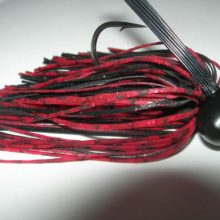This article may contain affiliate links. If you make a purchase after clicking on a link we may earn a small commission at no extra cost to you. As an Amazon Associate, I earn from qualifying purchases.
Jig Setup for Bass

Getting the best out of your jig fishing means fine tuning you jig setup for bass so that it allows you to get the most life into the jigs when working in deep cover.
Most modern jig setups use a fast action rod and a baitacaster reel paired with a low stretch line like fluorocarbon.
That low stretch is important as you need to get some life into the jig by twitching the rod tip and it also allows you to set the hook quickly.
A quick hook set is important when jigging as you might need to turn the bass away from heavy weed or other such structures before they get a chance to run towards them.
Jig Setup for Bass
1. Rod
The best jig rods will be casting rods with a medium/heavy power rating or heavy if you are working in really thick weed cover.
Power describes what weight line that the rod is rated for and how heavy a lure that it can handle.
They should be 7 feet in length in length as you will be flipping into cover and that extra length will also help to put a bit of life into the jig with just a quick flick of the wrist.
Just like most single hook lures a jig setup needs a rod with a fast action.
A fast action starts to bend up high on the rod blank in the top one third from the tip.
A more moderate action will have it’s bend start lower down the blank.
A fast action allows you to set the hook quickly and it also gives you good feedback down through the rod blank so you have some idea about what is going on at the lure.
Faster action rods also make it much easier to put some life into the jig. With a moderate action the rod blank would absorb a lot of the energy you would be trying to put into the line.
Most modern bass fishing poles will be made from graphite and for jigging it really is the best option in terms of action and weight.
2. Reel
A high speed baitcaster is definitely an advantage if you are looking to take up line quickly and try to haul bass out of thick weed or away from obstructions.
Try to run a reel with a 7.2:1 gear ratio or higher.
I don’t like to set the drag too light as you may need to get that bass out of cover quickly I you really do not want it taking too much line off of your spool once hooked.
3. Line
If you are casting into clearer waters over gravel or very light short grass then you’ll need a line that is less visible than braid but low stretch unlike monofilament and this is where fluorocarbon really shines.
For lighter jigs in the 3/8 to 1/2 ounce range I’d run 12 to 20 lbs fluorocarbon line.
If you are fishing larger jigs in dense weed then 40 lb braid if using a medium heavy rod or even as high as 50/60 lbs braid if you are using a heavy power rod and throwing jigs into really thick weed beds.
I usually prefer to use a fluorocarbon leader when running braid as a main line as braid is just so visible I rarely like it tied directly to any single hook lure like a jig.
